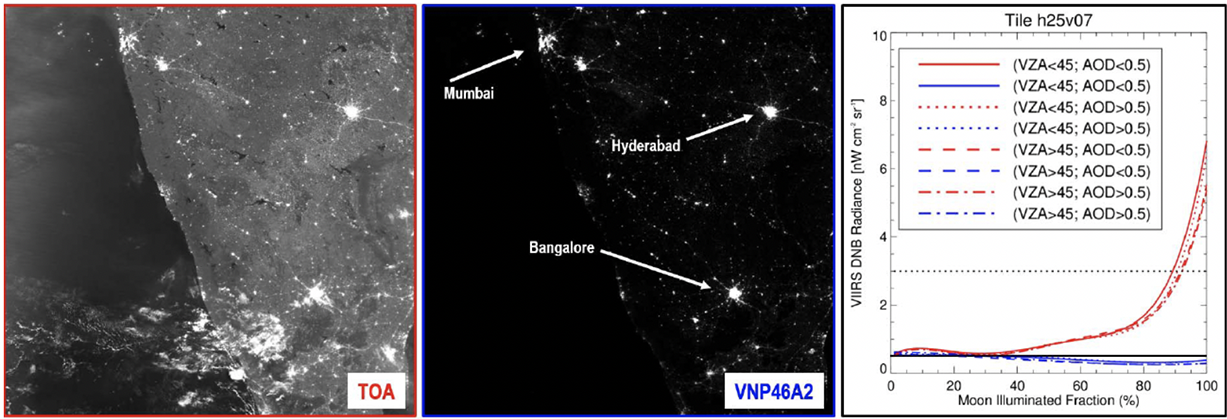VIIRS Black Marble Nighttime Light Product Validation
Version 1 Validation Statement
Validation at stage 1 has been achieved for the Black Marble nighttime light (NTL) products (VNP46). The evaluation activity from a stable point light source deployed in Puerto Rico indicates that the Black Marble NTL product can successfully detect a daily change of 0.45 nW cm-2 sr-1 (Román et al., 2018).
Extensive benchmark tests at representative spatial and temporal scales were conducted on the VNP46 time series record (Collection 1) to characterize the uncertainties stemming from upstream data sources. Initial validation results are presented in Román et al., (2018) together with example case studies illustrating the scientific utility of the products. This includes an evaluation of temporal patterns of nighttime light (NTL) dynamics associated with rapid urbanization, socioeconomic factors, cultural characteristics, and the living conditions of displaced populations affected by natural hazards and conflict.
The sources of Black Marble nighttime light uncertainty, due to view illumination geometry, surface Bidirectional Reflectance Distribution Function (BRDF)/albedo, and the effects of snow cover, lunar irradiance, aerosol loading, cloud mask, vegetation, geometry, and ephemeral artifacts (e.g., the Aurora Borealis) have been quantified based on global temporal VNP46 products (Wang et al., 2021).
An intercomparison was conducted to evaluate the influence of the spectral response functions of SNPP, NOAA-20, and NOAA-21 on DNB retrievals (Román et al., 2024). The SNPP DNB RSR on-orbit change was mainly due to the degradation of the rotating telescope assembly (RTA) mirrors during early stages of the mission. The DNB RSR change was faster in the first year on orbit, with the peak shifting from NIR toward a “blue” wavelength. NOAA-20 DNB RSR had no visible variation on-orbit. The DNB onboard SNPP, NOAA-20, and NOAA-21 are calibrated monthly. As a result, the impact of the SNPP DNB RSR change was relatively small for traditional light sources such as Ceramic Metal Halide and High Pressure Sodium. The NOAA-20 DNB radiance was ~6% lower than SNPP for LED at Rome. No DNB RSR adjustments were applied among SNPP, NOAA-20, and NOAA-21 in C2 reprocessing, considering the complex spectra of the different light types being observed.

Figure 1. NTL View Zenith Angle and Aerosol Optical Depth Benchmark test #1. The Daily VIIRS TOA (cloud-corrected at-sensor DNB radiances) and the VNP46A2 product (cloud-free, atmospheric-, seasonal-, and moonlight BRDF-corrected DNB nighttime radiances) are shown in the first and second panels, respectively, during near- to full-moon conditions. Cloudy pixels were left visible in the TOA product for viewing purposes. Benchmark test #1 is plotted in the right panel for each scene, TOA in red, VNP46A2 in blue. For reference, the threshold (Lmin=3.0 nW cm-2 sr-1) and breakthrough (Lmin=0.5 nW cm-2 sr-1) performance specifications are shown as black-dotted and solid horizontal lines, respectively.
Supporting Studies
Wang, Z., Román, M.O., Kalb, V.L., Miller, S.D., Zhang, J., Shrestha, R.M., 2021. Quantifying uncertainties in nighttime light retrievals from Suomi-NPP and NOAA-20 VIIRS Day/Night band data. Remote Sensing of Environment. 263, 112557 https://doi.org/10.1016/J.RSE.2021.112557.
Román, M. O., Z. Wang, Q. Sun, V. Kalb, S. D Miller, A. Molthan, L. Schultz, J. Bell, E. C. Stokes, B. Pandey, K. C Seto, D. Hall, T. Oda, R.E. Wolfe, G. Lin, N. Golpayegani, S. Devadiga, C. Davidson, S. Sarkar, C. Praderas, J. Schmaltz, R. Boller, J. Stevens, O.M. Ramos Gonzalez, E. Padilla, J. Alonso, Y. Detrés, R. Armstrong, I. Miranda, Y. Conte, N. Marrero, K. MacManus, T. Esch, E.J. Masuoka, (2018) NASA's Black Marble nighttime lights product suite, Remote Sensing of Environment, 210,113-143, https://doi.org/10.1016/j.rse.2018.03.017
Román, M. O., Justice, C., Paynter, I., Boucher, P. B., Devadiga, S., Endsley, A., Erb, A., Friedl, M., Gao, H., Giglio, L., Gray, J. M., Hall, D., Hulley, G., Kimball, J., Knyazikhin, Y., Lyapustin, A., Myneni, R. B., Noojipady, P., Pu, J., … Wolfe, R. (2024). Continuity between NASA MODIS Collection 6.1 and VIIRS Collection 2 land products. Remote Sensing of Environment, 302, 113963. https://doi.org/10.1016/J.RSE.2023.113963


